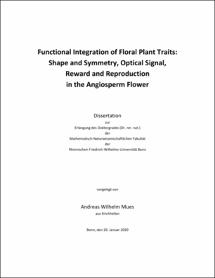Functional Integration of Floral Plant Traits: Shape and Symmetry, Optical Signal, Reward and Reproduction in the Angiosperm Flower

Functional Integration of Floral Plant Traits: Shape and Symmetry, Optical Signal, Reward and Reproduction in the Angiosperm Flower

| dc.contributor.advisor | Weigend, Maximilian | |
| dc.contributor.author | Mues, Andreas Wilhelm | |
| dc.date.accessioned | 2020-05-12T07:59:53Z | |
| dc.date.available | 2020-05-12T07:59:53Z | |
| dc.date.issued | 12.05.2020 | |
| dc.identifier.uri | https://hdl.handle.net/20.500.11811/8368 | |
| dc.description.abstract | Pollination syndromes represent groups of floral phenotypes that have originated and diversified in interaction with biotic and abiotic pollen vectors. Plant trait pattern that constitute respective syndromes have been used extensively to predict pollen vectors. However, research in this field has seemingly suffered from poor data quality and insufficient integration of important traits. Main objective of this dissertation is to contribute to better understanding of floral functional integration. Methods of choice are hierarchical clustering, Nonlinear Multidimensional Scaling and vector fitting, amongst others. The following study groups were selected: In chapter II diversification of floral plant traits and pollinator guilds are presented for members of order Geraniales. The order is small but florally diverse, and therefore particularly suitable for comparative studies. Floral symmetry in this order appears to be uncorrelated to quantitatively assessed gamete production and nectar reward. In chapter III diversification of floral plant traits and flowering time are analysed for Hamamelidaceae, a small family known for the peculiar flowering time of some of its members in late autumn or winter. Clear clusters of anemophilous, zoophilous and ambophilous pollination syndromes are retrieved, uncorrelated to flowering time. In chapter IV floral plant traits of carnivorous active flypaper plants Pinguicula and Drosera are compared. Carnivorous plants are animal pollinated, and the potential capture of legitimate pollinators has long been researched under the term pollinator-prey conflict. Analysis of floral plant traits proves the absence of such a conflict. In chapter V subsets of floral functional traits are analysed for 18 members of Streptocarpus subgenus Streptocarpus. The subsets appear to be largely uncorrelated and show an arbitrary distribution on the phylogenetic tree. Reported flower types of the subgenus, commonly described as indicators for pollination syndromes, only correlate to floral architecture. In chapter VI crossing experiments between three closely related Streptocarpus species of the Cape primrose clade demonstrate vigorous seed set. The experiment proves the absence of postzygotic crossing barriers and supports the theory of a large, single gene pool underlying the subgenus. Prezygotic barriers such as eco-geographical isolation, including control of plant-animal interactions via floral architecture and optical attraction, appear to keep the species separated in the field. In chapter VII a more extensive crossing experiment with nine parental species of Streptocarpus subgenus Streptocarpus is presented. Floral architecture, optical signal and nectar reward of 40 hybrids is presented. Hybrids predominantly show full floral function. Establishment of functional hybrid swarms in the field and onset of homoploid hybrid speciation is therefore possible, if a freak pollination event circumvents established prezygotic crossing barriers. Chapter VIII presents general conclusions of this thesis. All in all, the quantitative and qualitative, integrative assessment of floral plant traits appears as a promising approach for better understanding of floral function, and is an improvement compared to the widespread assessment of pollination syndromes only based on floral colours and shapes. | en |
| dc.language.iso | eng | |
| dc.rights | In Copyright | |
| dc.rights.uri | http://rightsstatements.org/vocab/InC/1.0/ | |
| dc.subject | Floral traits | |
| dc.subject | pollination syndromes | |
| dc.subject | p/o ratio | |
| dc.subject | nectar reward | |
| dc.subject | optical signal | |
| dc.subject | symmetry | |
| dc.subject | Geraniales | |
| dc.subject | Hamamelidaceae | |
| dc.subject | Droseraceae | |
| dc.subject | Pinguicula | |
| dc.subject | Streptocarpus | |
| dc.subject.ddc | 570 Biowissenschaften, Biologie | |
| dc.subject.ddc | 580 Pflanzen (Botanik) | |
| dc.title | Functional Integration of Floral Plant Traits: Shape and Symmetry, Optical Signal, Reward and Reproduction in the Angiosperm Flower | |
| dc.type | Dissertation oder Habilitation | |
| dc.publisher.name | Universitäts- und Landesbibliothek Bonn | |
| dc.publisher.location | Bonn | |
| dc.rights.accessRights | openAccess | |
| dc.identifier.urn | https://nbn-resolving.org/urn:nbn:de:hbz:5-58503 | |
| ulbbn.pubtype | Erstveröffentlichung | |
| ulbbnediss.affiliation.name | Rheinische Friedrich-Wilhelms-Universität Bonn | |
| ulbbnediss.affiliation.location | Bonn | |
| ulbbnediss.thesis.level | Dissertation | |
| ulbbnediss.dissID | 5850 | |
| ulbbnediss.date.accepted | 30.04.2020 | |
| ulbbnediss.institute | Mathematisch-Naturwissenschaftliche Fakultät : Fachgruppe Biologie / Nees-Institut für Biodiversität der Pflanzen | |
| ulbbnediss.fakultaet | Mathematisch-Naturwissenschaftliche Fakultät | |
| dc.contributor.coReferee | Fischer, Eberhard |
Files in this item
This item appears in the following Collection(s)
-
E-Dissertationen (4115)




